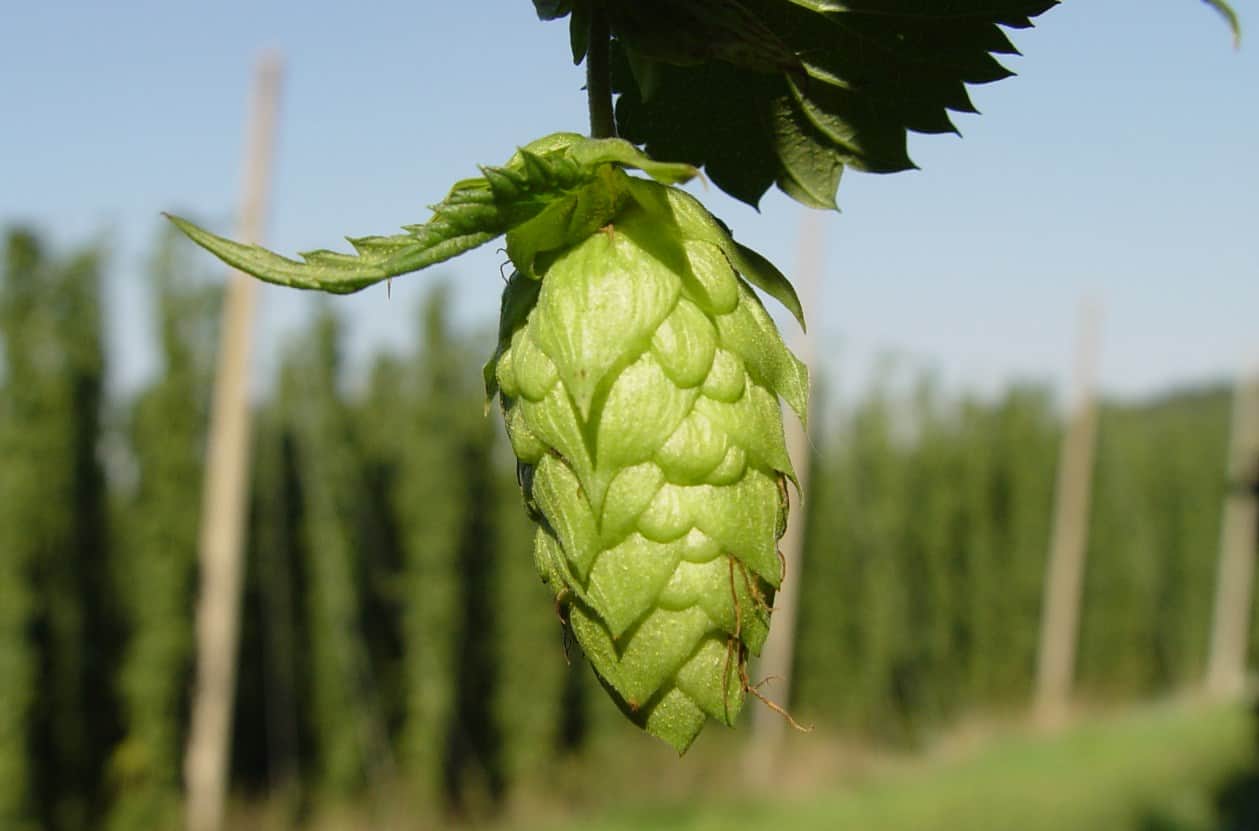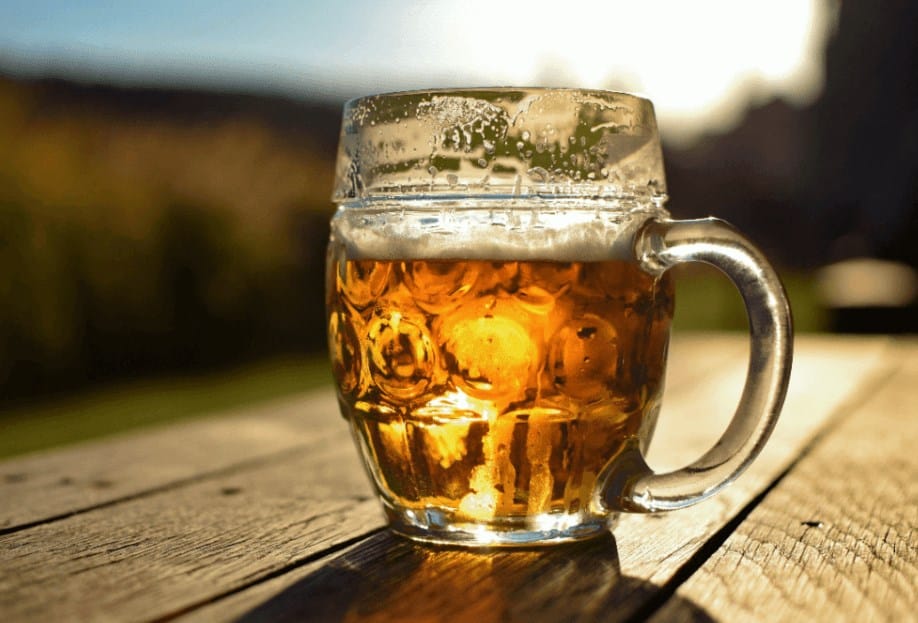- Pilsner Malt Guide: Everything You Need to Know - May 22, 2022
- Brooklyn BrewShop Bear Kits Review and Guide: My Step-By-Step Experience Making This Beer - December 5, 2021
- The Ultimate Comet Hops Guide to this Rising Star Hop - October 29, 2021
Saaz hops are considered “noble hops”, which means that it is one of a few hops that are used in traditional European brewing, are wildly occurring, low in bitterness, and high in aroma. The category of “noble hops” is small and has no legal requirements. It can really be traced back to marketing counteracting man-made and man-altered hops taking place now more than ever.
Saaz hops are most notably used in Pilsners and Lagers, particularly Czech and Czech-style Pilsners and Bohemian and Bohemian-style Lagers. But where did they come from, what do they actually add to the beer, and what can we expect to see from them in the future? Read our Saaz Hops Guide to find out.
A Little About Hops
Hops are cone-like structures, which are the flowers or buds that come from the hop plant. The hop plant can grow in a lot of different locations if they have good soil, sunlight, water, and a trellis to grow up.
Rather than being called vines, hop plants are called bines. While vines produce grapes for wine, bines produce hops for beer. So the hop buds grow on the hop bines until they are ready to be harvested. They are harvested in the hottest time of year for whatever area the hops are being grown. Next, they are dried and eventually end up in beer mash for several reasons.
Hops were originally added to beer to preserve the beer in the long journeys to India made by the East India Trading Company. That journey and addition of hops eventually gave birth to the IPA or India Pale Ale. Because people not only were drinking beer that hadn’t turned in the hull of a ship for six months, they found that they genuinely enjoyed the new flavors that were happening. The bitterness that the hops created in the beer being transported ended up not only acting as a preservative but adding to the tasting profile in a positive way.
Soon, people realized that adding and mixing certain hops would change the flavor of beers immensely. Hops can be floral, earthy, bitter, juicy, and more! They really are what makes a beer unique.
Today, many hops are cross-bred and created for the desired flavor and optimal impact. The hop world is certainly big and continues to grow. But that’s for another time, let’s discuss one of the original and naturally occurring hops: Saaz!
Saaz Hops History

Saaz hops are an important player in both Pilsners and Bohemian-style Lagers, as their history is intricately tied in with Czech Pilsners: one of the most iconic and delicious styles of Pilsners in the world. So let’s talk about all that history for a moment!
Saaz hops were originally discovered in Zatec, Bohemia. At the time, Zatec was a German province, but now it is part of the Czech Republic. Zatec translates to Saaz in German, hence the name Saaz. Saaz hops have been diligently monitored and regulated since the 1500s to ensure the protection of the hop varietal and consistency in its production for the present and future drinkers.
Saaz hops are low in alpha acid content and high in polyphenols, which is unique in hops. Those two chemical elements reduce oxidation and extend shelf life. This makes Saaz efficient because it makes it more naturally resistant to mildew. Of course, it isn’t mildew-proof, it just has chemical components that make mildew less likely.
In a world of cloned, frozen, hybrid, and just man-made created hops, Saaz hops are unique because they are naturally occurring. They have thrived in the Czech Republic, the very place they were discovered, specifically, for years. Their success in growing in the Czech Republic gave rise to their usage in the iconic Czech Pilsners, and as the world got smaller, Czech-style Pilsners.
Saaz is popular not only for its taste, which we will get to in a little bit, but it’s also popular because it’s functional. Saaz hops are hearty and produce a high yield. And as I said earlier, they also have a naturally strong resistance to mildew, which is a huge plus.
Czech Pilsners vs Czech-style Pilsners

Czech and Czech-style Pilsners are similar but not the same.
Czech Pilsners can also be referred to as Bohemian Pilsners. They are defined as Pilsners made in the Czech Republic. It’s pretty simple and straightforward! The name “Pilsener” translates from Czech to “from Pilsen” because Pilseners were invented in the Czech city of Pilsen. So you can’t really discuss Pilseners without addressing their roots in the Czech Republic.
Czech-style Pilsners are simply Pilsners made in the style of a Czech Pilsner without being from the Czech Republic. Many breweries do their own rendition of Czech Pilsners and utilize Saaz hops to try to imitate and pay homage to the godfather of Pilsners. See below for some American Czech-style Pilsners worth your time!
German Pilsners

The Czech Pilsner pre-dates the German Pilsner, as we know that the German Pilsner recipe was altered to accommodate their water in Germany, which was more minerally than the Czech Republic. There were also different local hops growing naturally in Germany to utilize for their own Lagers and Pilsners. And therefore: a new style was born of the old sometime in the 1870s: the German Pilsner.
In fact, in Germany, you would not just order “a Pilsner” because it’s important to differentiate which style of Pilsner you want: German or Czech. This is vital information for your bartender, but also a nod of respect to hundreds of years of Czech brewers.
American Pilsners

The best I can say is that over here in America, we are catching up to European Pilsners. Prohibition halted American craft brewing, making the market ripe for consumers drinking whatever they could get once Prohibition was repealed in 1933. The result was macro brewing with breweries like Budweiser and Miller Lite pumping out large amounts of unpolished product. Those macro companies were giving their market what they wanted: something alcoholic and drinkable, taste sort of came secondary.
I have also heard a theory that macro breweries sought to compete with the non-alcoholic drinks of the last thirteen years. Those drinks would’ve been sweet things like sodas and shakes. Making a beer for that audience had to keep up with those flavors. And hence, the American Pilsner was born.
In Europe, those macro brews are not even allowed to be called Pilsners. Yes, read that again. That’s how gross they think they are!
Today, the American beer market is making great strides in earning the respect of European brewers and drinkers. Day by day, beer by beer, we learn and create better and better brews.
Saaz Hops Tasting Notes
Saaz hops are mild and delicate and when it comes to how they play out in beer, they are primarily used to add notes to the nose of the beers they are in. In fact, Saaz hops are almost always used for their aroma in a beer, rather than bittering. This is just another way that they are unique from other hops, which often are used to bitter beers.
Saaz hops bring earthy, herbal, and spicy flavors to the beers they are in. On their own, you will get hints of pepper or nutmeg. Those herbal, spicy, and earthy notes are now strongly associated with Pilsners thanks to Saaz hops and the Czech Republic for utilizing them so well for so long.
Pilsners in general are usually floral on the nose with light carbonation. They have a soft palate of biscuity maltiness with a crisp finish. One of the complaints about American Pilsners has often been that they are overly carbonated. Heavy carbonation isn’t a characteristic in European Pilsners.
Growing Saaz Hops

Growing Saaz hops is possible depending on where you live and how much space and time you can give these plants.
Firstly, Saaz hops need rich soil and regular watering. They need full exposure to sunlight and a sturdy structure, or trellis, to grow up. They also need to be protected from mildew and things like unexpected frost. These plants need attention and time, so purchase if you have those things for them as well as a proper place to grow in.
Even though New England can be quite cold and dreary for a lot of the year, you can still grow Saaz hops there. Consider or look up the climate in the Czech Republic if you’re on the fence about whether or not Saaz hops would do well in your garden. If your climate and soil is similar to that of the Czech Republic, go for it!
You Can’t-Miss These Saaz Hops Beers
- You cannot mention Saaz hops or Czech Pilsners without mentioning Pilsner Urquell, one of the most iconic beers in the world. This Czech Pilsner is floral on the nose, with a crisp malty dryness on the palate. Due to its popularity, you should be able to find it easily at a liquor store near you.
- Notch Brewing out of Salem, Massachusetts makes one of the best Czech-style Pilsners on the American market: Notch Session Pils. It’s low in abv, crushable, malty, crisp, and true to its inspiration. The only hops used are Saaz! This is a must-have for any Pilsner fan, especially if you’re into Czech Pilsners!
- Schilling Beer Company out of New Hampshire makes Alexandr, a Czech-style Pilsner that is to die for! This little gem doesn’t tell you what hops it uses, but whatever they’re doing: it’s working!
- Jack’s Abby Brewing makes a beautiful Czech-style Pilsner called the Sunny Ridge. While this is a blend of European hops, it is still a gorgeous interpretation of the Czech Pilsner. The bad news is it’s only available from February through April.
Saaz Hops FAQs
Question: Can you grow your own Saaz hops?
Answer: Yes, you can buy them off of multiple sites but just make sure you read about how they need to be cared for first! You need space, time, and effort for projects like growing your own hops.
Question: Are Saaz hops in IPA’s or beers that aren’t Pilsners or Lagers?
Answer: Yes, there is no reason they can’t be put in any beer. Saaz hops are simply used for aroma, not adding a bitter taste. They can be easily overpowered on the palate, therefore, so if you see Saaz hops are used in a beer you’re enjoying, make sure you stop to take in the nose.
Question: Are they still considered Saaz hops if grown outside of the Czech Republic?
Answer: Yes. It is simply not a Czech Pilsner unless it comes from the Czech Republic. It is only Czech-style, similar to London Dry Style Gin.
Question: Are Saaz hops naturally occurring?
Answer: Yes, they are completely natural though I have read about people trying to make adjustments to make the hop even more mildew-resistant.
Question: Are Saaz hops bitter?
Answer: Not really. They are more floral and earthy forward than anything else. If you can get your hands on true Czech Pilsner and really get a good whiff, you will see what I’m talking about!
Final Thoughts on Saaz Hops
There are a lot of hops being thrown around in beers nowadays, so when it comes to the roots of brewing and hops in general, it’s always cool to see where something started. Saaz hops are a sort of beginning for hops and hop development. Without their impact on brewing, where would the world be today?
Because of Prohibition, American craft brewing really slowed down. Today, you can enjoy solid Pilsners from America or you can enjoy tried and true classics from Europe. Whatever you reach for, don’t think that because it’s a Pilsner or a Lager it’s boring. Pilsners and Lagers are the “naked” beers, made to be stripped down to their biscuity, florally notes. In that sense, you never order “a Lager” or “a Pilsner”, you’re ordering a piece of beer culture history.
So cheers to Pilsners, Lagers, and Saaz hops!

